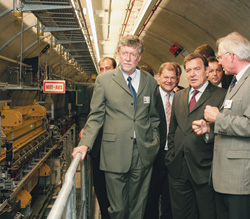 Photo: DESY |
VIP at DESY
He boldly pressed the red button and said, "They promised to explain to me afterwards what I am doing here exactly."
And the director kept that promise: "With this push of a button you have opened, like in a camera, the shutter to take pictures with this pioneering facility for free-electron lasers. Flashes of laser-like X-ray light are now available for science," he said.
The scene of the action: an experimental hall at DESY in Hamburg, Germany, on August 3, 2005. The actors: German Chancellor Gerhard Schröder and DESY's director-general Albrecht Wagner, facing some 50 representatives from the media. The occasion: the dedication of the world's first vacuum ultraviolet free-electron laser (VUV-FEL), a machine that sets new standards: ten million times the peak brilliance of the best synchrotron radiation sources today; coherent radiation; light pulses of only 10 to 50 femtoseconds duration; tiny wavelength, tunable from 6 to 30 nanometers.
At the dedication, Wagner, Schröder and DESY's Jochen Schneider (photo, left to right) took a walk through the VUV-FEL tunnel. During its first phase of operations, a total of 29 VUV-FEL research projects will be carried out by 200 scientists from 60 institutes in 11 countries. The experiments focus on fields such as cluster physics, solid state physics, surface physics, plasma research, and molecular biology. Demand for beam time is high, and researchers interested in many more projects are already knocking at the door.
The startup of the VUV-FEL is of great interest to the accelerator community. A main component of the 260-meter-long facility is a linear accelerator that uses superconducting radio-frequency technology, developed at DESY by the TESLA Collaboration from 1992 to 2004. The same technology is also at the heart of two even larger projects. By 2012, DESY and its international partners will build a 3.4-kilometer "FEL big brother," the European X-ray laser (XFEL). And the design of the approximately 40-kilometer-long International Linear Collider, a global project, features superconducting technology, too.
Petra Folkerts, DESY
Click here to download the pdf version of this article.






